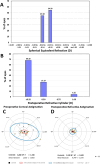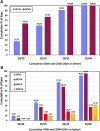Visual outcomes with a non-diffractive enhanced depth-of-focus IOL in patients with age-related macular degeneration
- PMID: 40584705
- PMCID: PMC12203608
- DOI: 10.3389/fmed.2025.1505401
Visual outcomes with a non-diffractive enhanced depth-of-focus IOL in patients with age-related macular degeneration
Abstract
Purpose: To evaluate visual function in eyes with age-related macular degeneration (AMD) implanted with a non-diffractive enhanced depth-of-focus (EDOF) intraocular lens (IOL) after cataract surgery.
Design: Prospective, observational, non-randomized clinical study.
Methods: Twenty-two eyes from 22 patients diagnosed with AMD and cataracts were submitted to standard cataract surgery with a non-diffractive EDOF IOL implantation (AcrySof IQ Vivity). We measured monocular uncorrected and best-corrected-distance visual acuity (UDVA and CDVA), uncorrected- and distance-corrected-intermediate visual acuity (UIVA and DCIVA), uncorrected- and distance-corrected-near visual acuity (UNVA and DCNVA), manifest refractive spherical equivalent (MRSE) and cylinder, monocular defocus curve and patient-reported outcome questionnaires (Catquest-9SF and NEI VFQ-25). Follow-up visits were carried out at 1, 3 and 6 months post-surgery.
Results: At 6 months post-surgery all eyes were within ± 0.50 D with a mean MRSE of -0.19 ± 0.20 D, 95.45% had a refractive cylinder of ≤ 0.50 D with a mean cylinder of -0.24 ± 0.27 D. The mean values of postoperative monocular CDVA, DCIVA, and DCNVA were 0.02 ± 0.08, 0.16 ± 0.11, and 0.26 ± 0.15 logMAR, respectively. The defocus curve showed good visual acuity at distance and intermediate with a depth-of-focus of about 1.60 D. A total of 81.82% of patients did not report any difficulty with their vision in their everyday-life and 86.36% reported being quite satisfied to very satisfied with their current vision. The NEI VFQ-25 showed that all values improved significantly (p < 0.05) after the surgery in the different parameters analyzed except for ocular pain (p = 0.390) and color vision (p = 0.333).
Conclusion: The use of a non-diffractive EDOF IOL in AMD eyes with cataracts is a safe and effective surgical approach for visually correcting aphakia, providing good visual acuity at far and intermediate distances. Our outcomes support the use of non-diffractive EDOF IOLs in patients with AMD diagnosed with cataracts aiming to obtain spectacle-independence at far and intermediate distances.
Keywords: age-related macular degeneration; cataracts; enhanced depth-of-focus; intraocular lens; patient satisfaction.
Copyright © 2025 Elvira, Devesa, Elvira-Giner, Tañá-Sanz, Orts-Vila and Tañá-Rivero.
Conflict of interest statement
The authors declare that the research was conducted in the absence of any commercial or financial relationships that could be construed as a potential conflict of interest.
Figures





Similar articles
-
Trifocal intraocular lenses versus bifocal intraocular lenses after cataract extraction among participants with presbyopia.Cochrane Database Syst Rev. 2023 Jan 27;1(1):CD012648. doi: 10.1002/14651858.CD012648.pub3. Cochrane Database Syst Rev. 2023. PMID: 36705482 Free PMC article.
-
Visual and Refractive Outcomes After Implantation of an Isofocal Optic-Design Intraocular Lens with Double C-Loop Haptics in Japanese Eyes.Clin Ophthalmol. 2025 Jul 29;19:2453-2462. doi: 10.2147/OPTH.S535100. eCollection 2025. Clin Ophthalmol. 2025. PMID: 40757167 Free PMC article.
-
A comparative study and review of visual outcomes with enhanced versus standard monofocal intraocular lenses following cataract surgery.Med Hypothesis Discov Innov Ophthalmol. 2025 Jul 31;14(2):28-39. doi: 10.51329/mehdiophthal1521. eCollection 2025 Summer. Med Hypothesis Discov Innov Ophthalmol. 2025. PMID: 40787279 Free PMC article.
-
Visual Outcomes of a New Hydrophobic Trifocal Intraocular Lens in Cataract Treatment: A Prospective Clinical Study.J Ophthalmol. 2025 Jul 24;2025:2662730. doi: 10.1155/joph/2662730. eCollection 2025. J Ophthalmol. 2025. PMID: 40746764 Free PMC article.
-
Blue-light filtering intraocular lenses (IOLs) for protecting macular health.Cochrane Database Syst Rev. 2018 May 22;5(5):CD011977. doi: 10.1002/14651858.CD011977.pub2. Cochrane Database Syst Rev. 2018. PMID: 29786830 Free PMC article.
References
LinkOut - more resources
Full Text Sources

